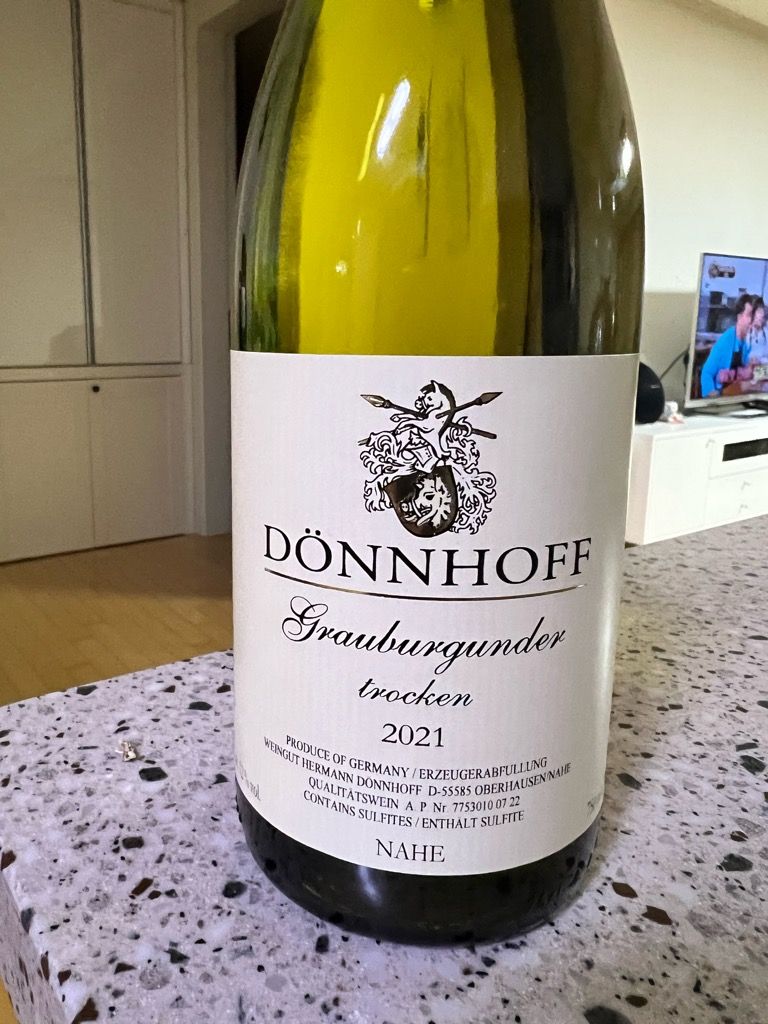
External search
Google (images)
Wine Advocate
Wine Spectator
Burghound
Wine-Searcher
Vintages
2022
2021
2020
2019
2018
2017
2016
2015
2014
2013
2012
2011
2010
2006
2005
2004
2002
1999
From this producer
Show all wines
All tasting notes
|
| Drinking Windows and Values |
| Drinking window: Drink between 2022 and 2027 (based on 12 user opinions) |
| Community Tasting History |
| Community Tasting Notes (average 90.3 pts. and median of 90 pts. in 3 notes) - hiding notes with no text | | | Tasted by Schiffy on 7/7/2023 & rated 90 points: Dry, crisp and tasty riesling with notes of almond, apple and apricots. Nice long finish. (189 views) | | | Tasted by 3daywinereview.com on 6/16/2022 & rated 90 points: Donnhoff Tasting (St. Paul): Spice, floral, dust and minerals. Short to medium finish. Solid effort. (1048 views) |
| Dönnhoff Producer website
U.S. Importer (add'l info)
As a help to those who purchase and cellar these wines, let it be noted that the 'Goldkapsule' does not ofen designate a higher quality bottling from the producer Dönnhoff. Herr Dönnhoff uses gold capsules on about 99 percent of the l bottlings of certain richer wines from the vineyards Oberhauser Brücke and Niederhauser Hermannshöhle and perhaps some others. Therefore it is usually unneccessary and misleading to use the term 'Goldkapsule' with Dönnhoff wines, currently. Although, just to be confusing, David Bueker mentions that there may be one or two exceptions, especially in 2001 and 2003 vintages, where Donnhoff produced "white capsule" auslesen from the Leistenberg and Dellchen vineyards (later Dellchen auslesen have gone to the gold capsules - e.g. 2006). To have to list my notes on a Cellartracker page that has a non-necessary and meaningless 'gold capsule' designation is highly irritating for me, as I feel that if I list it correctly it won't even be picked up by a search.
Another example of the confusion above is with the frequent multiple bottlings of Eisweine from the Brücke vineyard. There were at least three bottlings in 1998 and three in 2002. They occur when prolonged cold snaps allow harvesting on successive days. Usually one of these is designated the 'regular' Eiswein and the best one is sent to the Auction. Each typically has a different style. They are informally referred to by the day of the week on which they were harvested. Thus in 1998 there was a 'Samstag' Eiswein, and one for 'Sonntag' and also 'Montag'. The last named is extremely powerful, and extremely expensive; it is the Auction lot.
It is STRONGLY URGED then that when referring to Dönnhoff wines one refers to the AP number If this terminology is not used, identity can be impossible to determine. JHTTrocken Wikipedia about Trocken (German)Germany Wines of Germany | The Association of German Prädikat Wine Estates (VDP) | How to read a German wine label | Geographical Information Down to Single Vineyards
#2014 Vintage Notes:
2014 Vintage Report by Terry Theise
2014 Vintage Report by Wine Spectator
"My gut still tells me the Saar (and to some extent) the Ruwer are better overall in 2014 than the more storied areas of the Mosel proper, but those that spent the requisite time living in their middle-Mosel vineyards made some of the most electric and "feathery" Riesling in a long time (maybe the finest in 20 years - yes, it's true!)" - Jon Rimmerman (Of course only a very short historical memory would call the Saar and Ruwer less 'storied' than the middle Mosel - jht)NaheAn der Nahe erwarten den Besucher sanftes Grün, romantische Flusstäler und dramatische Felsformationen. Dazu gastfreundliche Winzer und ihre vielfältigen Weine.
2.000 Jahre Weinbautradition hat das Anbaugebiet an der Nahe und den Nebenflüssen Glan und Alsenz. Vor kalten Winden durch den hohen Hunsrück geschützt, schaffen milde Temperaturen und viel Sonnenschein ein hervorragendes Klima für den Weinbau in dem regenarmen und sonnigen Tal. Hier wachsen auf rund 4.000 Hektar Rebsorten wie Riesling, Rivaner, und Silvaner. Auch die Spielarten des Burgunders sowie Kerner, Scheurebe, Portugieser und Dornfelder sind hier zu Hause. Lieblingskind der Winzer ist der an Finessen reiche Riesling, ein Viertel der Rebfläche ist damit bestockt.
Eine bewegte Erdgeschichte hat der Nahe-Region eine große Bodenvielfalt beschert. Die Reben wachsen auf Schiefergestein, vulkanischen Porphyr- oder Löss- und Lehmböden. Das ermöglicht eine Vielfalt an Rebsorten und Weinstilen.
Interactive map on weinlagen.info |
|




